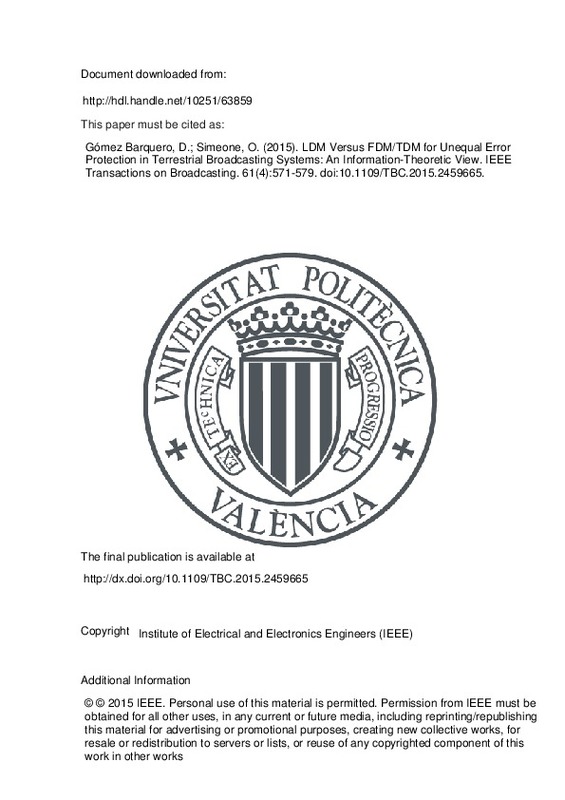JavaScript is disabled for your browser. Some features of this site may not work without it.
Buscar en RiuNet
Listar
Mi cuenta
Estadísticas
Ayuda RiuNet
Admin. UPV
LDM Versus FDM/TDM for Unequal Error Protection in Terrestrial Broadcasting Systems: An Information-Theoretic View
Mostrar el registro sencillo del ítem
Ficheros en el ítem
| dc.contributor.author | Gómez Barquero, David
|
es_ES |
| dc.contributor.author | Simeone, Osvaldo
|
es_ES |
| dc.date.accessioned | 2016-05-10T11:47:18Z | |
| dc.date.available | 2016-05-10T11:47:18Z | |
| dc.date.issued | 2015-12 | |
| dc.identifier.issn | 0018-9316 | |
| dc.identifier.uri | http://hdl.handle.net/10251/63859 | |
| dc.description | © © 2015 IEEE. Personal use of this material is permitted. Permission from IEEE must be obtained for all other uses, in any current or future media, including reprinting/republishing this material for advertising or promotional purposes, creating new collective works, for resale or redistribution to servers or lists, or reuse of any copyrighted component of this work in other works | es_ES |
| dc.description.abstract | In this paper, power-based layer-division multiplexing (LDM) is studied as a means to provide unequal error protection in digital terrestrial television (DTT) systems by adopting an information-theoretic approach. LDM can potentially offer fundamental performance gains as compared to traditional time-division multiplexing (TDM) or frequency-division multiplexing due to the reuse by all information layers of all the available time-frequency resources. The main use case of LDM for terrestrial broadcasting is the simultaneous provision of fixed and mobile services in the same channel. Since most DTT networks worldwide are dimensioned for fixed rooftop reception, this paper illustrates the performance comparison between LDM and F/TDM in terms of the capacity-coverage tradeoff of the mobile service for a given reduction of the capacity of the fixed service while keeping the coverage of the fixed service constant. A mathematical formulation, and corresponding numerical results, are provided for different fading channels, including single-input single-output, single-input multiple-output, multiple-input single-output, and multiple-input multiple-output antenna systems, and accounting also for the impact of non-ideal channel coding. | es_ES |
| dc.description.sponsorship | This work was supported by WWTF under Grant ICT12-054. | en_EN |
| dc.language | Inglés | es_ES |
| dc.publisher | Institute of Electrical and Electronics Engineers (IEEE) | es_ES |
| dc.relation.ispartof | IEEE Transactions on Broadcasting | es_ES |
| dc.rights | Reserva de todos los derechos | es_ES |
| dc.subject | Layered-Division Multiplexing (LDM) | es_ES |
| dc.subject | Non-Orthogonal Multiplex Access (NOMA) | es_ES |
| dc.subject | Unequal Error Protection | es_ES |
| dc.subject | Superposition Modulation | es_ES |
| dc.subject | Terrestrial broadcasting | es_ES |
| dc.subject.classification | TEORIA DE LA SEÑAL Y COMUNICACIONES | es_ES |
| dc.title | LDM Versus FDM/TDM for Unequal Error Protection in Terrestrial Broadcasting Systems: An Information-Theoretic View | es_ES |
| dc.type | Artículo | es_ES |
| dc.identifier.doi | 10.1109/TBC.2015.2459665 | |
| dc.relation.projectID | info:eu-repo/grantAgreement/WWTF//ICT12-054/ | es_ES |
| dc.rights.accessRights | Abierto | es_ES |
| dc.contributor.affiliation | Universitat Politècnica de València. Instituto Universitario de Telecomunicación y Aplicaciones Multimedia - Institut Universitari de Telecomunicacions i Aplicacions Multimèdia | es_ES |
| dc.description.bibliographicCitation | Gómez Barquero, D.; Simeone, O. (2015). LDM Versus FDM/TDM for Unequal Error Protection in Terrestrial Broadcasting Systems: An Information-Theoretic View. IEEE Transactions on Broadcasting. 61(4):571-579. https://doi.org/10.1109/TBC.2015.2459665 | es_ES |
| dc.description.accrualMethod | S | es_ES |
| dc.relation.publisherversion | http://dx.doi.org/10.1109/TBC.2015.2459665 | es_ES |
| dc.description.upvformatpinicio | 571 | es_ES |
| dc.description.upvformatpfin | 579 | es_ES |
| dc.type.version | info:eu-repo/semantics/publishedVersion | es_ES |
| dc.description.volume | 61 | es_ES |
| dc.description.issue | 4 | es_ES |
| dc.relation.senia | 298535 | es_ES |
| dc.contributor.funder | Vienna Science and Technology Fund | es_ES |







![[Cerrado]](/themes/UPV/images/candado.png)

